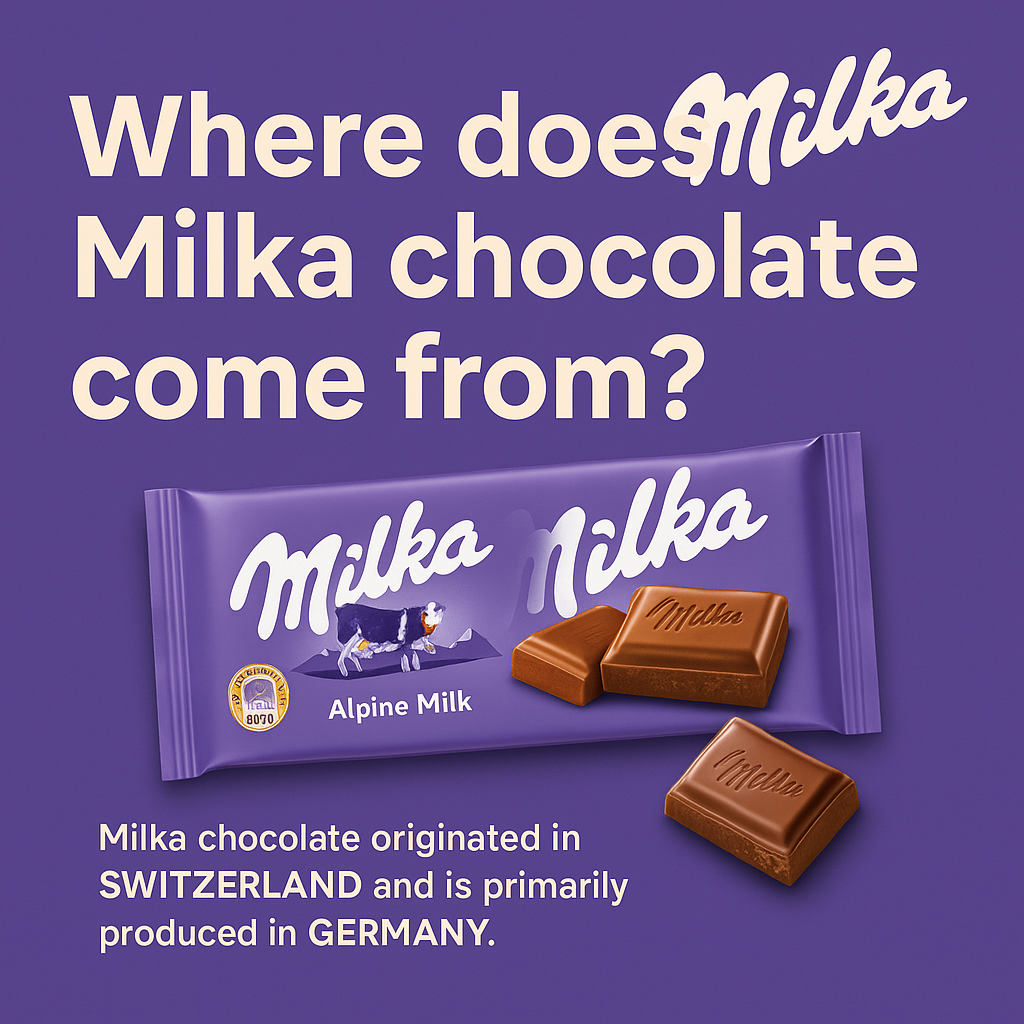If you’ve ever unwrapped a silky purple package of Milka chocolate, chances are you've wondered: where does Milka chocolate come from? Known for its melt-in-your-mouth texture and sweet alpine milk flavour, Milka has become a global chocolate icon—but its roots trace back to a very specific region and rich history in Europe.
In this post, we’ll answer that exact question, explore Milka’s history, unique ingredients, cultural impact, and why this European favourite continues to charm chocolate lovers around the world.
A Quick Answer: Where Does Milka Chocolate Come From?
Milka chocolate originated in Switzerland in 1901 but became most closely associated with Germany over the 20th century. Today, it’s produced primarily in Lörrach, Germany, where the largest Milka factory is located. However, its Alpine heritage—especially the use of Alpine milk—is still a core part of the brand’s identity.
The History of Milka Chocolate
Swiss Beginnings
Milka was first created by Suchard, a Swiss chocolatier founded by Philippe Suchard in 1826. The name "Milka" was trademarked in 1901 and is a portmanteau of two German words: “Milch” (milk) and “Kakao” (cocoa)—a nod to its creamy ingredients.
The chocolate gained popularity quickly across Europe due to its soft texture and accessible sweetness, compared to the darker, more bitter chocolates popular at the time.
German Expansion
Though its roots are Swiss, Milka’s production began shifting to Germany, specifically to the town of Lörrach in the Baden-Württemberg region, near the Swiss border. By the mid-20th century, Milka was firmly entrenched in the German market and became a staple in households across Europe.
Today, Lörrach remains the main production hub of Milka chocolate. This German connection often leads many to assume Milka is a German brand—though it truly bridges Swiss and German traditions.
The Iconic Purple Cow
One of Milka’s most recognizable features is its packaging—especially the purple cow, which has become a symbol of Alpine purity, fresh milk, and European chocolate-making tradition.
The purple colour was first used in the 1970s and helped cement Milka’s unique visual identity. Since then, the cow has remained front and centre in nearly all of Milka’s advertising and branding, reinforcing its image as a wholesome, creamy, and approachable chocolate.
What Makes Milka Chocolate So Creamy?
The standout feature of Milka chocolate is its use of Alpine milk, which is sourced from cows raised in the European Alps. This high-quality milk, known for its natural richness and purity, is blended with cocoa to create a smooth, velvety chocolate texture.
While other brands may focus on cocoa percentage or exotic ingredients, Milka leans into creaminess and sweetness, making it particularly appealing for everyday snacking, sharing, or gifting.
Global Reach, European Roots
Although Milka is now available worldwide—from Canada and the U.S. to Asia and South America—it remains deeply rooted in its European origins. The brand was acquired by Mondelēz International (formerly Kraft Foods) in 2012, helping expand its international presence while maintaining its Alpine identity.
The chocolate continues to be manufactured in Europe and exported globally, ensuring that every bar you unwrap—no matter where you are—still reflects that authentic European flavour.
Popular Milka Chocolate Varieties
Over the years, Milka has released dozens of varieties that showcase both classic and innovative flavours. Some of the most popular include:
- Milka Alpine Milk – The original and most iconic.
- Milka Oreo – A fusion of two snack powerhouses.
- Milka Hazelnut – A nutty twist on the classic.
- Milka Strawberry Cream – A fruit-forward favorite.
- Milka & Daim – With crunchy caramel bits inside.
- Milka Choco-Swing – Layered with biscuit and cream.
No matter the variation, the base Alpine milk chocolate remains a key part of the experience.
Fun Facts About Milka
- Over 150,000 cows are part of Milka’s Alpine milk supply chain.
- The Lörrach factory produces over 100,000 tons of chocolate every year.
- Milka is one of the top-selling chocolate brands in Europe, especially in Germany, France, and Poland.
- In 2011, Milka set a world record by creating the largest chocolate bar ever made—over 5,000 kg!
Why People Love Milka
The appeal of Milka goes beyond just flavor. Consumers often describe it as nostalgic, comforting, and familiar. Many people in Europe grew up with Milka bars in their lunchboxes or as treats during holidays.
In markets outside Europe, Milka is seen as a premium import, representing authentic European chocolate craftsmanship. Its smoothness, high-quality ingredients, and attractive packaging make it a go-to for anyone seeking a milder, creamier chocolate.
Where to Buy Milka Chocolate
If you're craving Milka and wondering where to get it, you're in luck. While local availability varies, Milka is often found at:
- International snack stores (like InOutSnackz!)
- Online candy shops
- European grocery imports
- Amazon and major retailers
Pro tip: At InOutSnackz, you can explore different Milka flavours imported directly from Europe—no travel required.
Final Thoughts: Milka’s Timeless Appeal
So, where does Milka chocolate come from? While it was born in Switzerland and raised in Germany, the true answer is that Milka comes from a rich European tradition of chocolate-making, where quality, creaminess, and heritage meet.
From its Alpine milk roots to its purple cow mascot, Milka remains one of the world’s most beloved chocolate brands. Whether you’re trying it for the first time or revisiting a childhood favourite, Milka always delivers the same smooth, comforting sweetness that has delighted generations.
Want to try Milka for yourself?
Check out our curated collection of imported Milka chocolate bars and other European treats—no subscription required, just delicious snacks delivered to your door.

